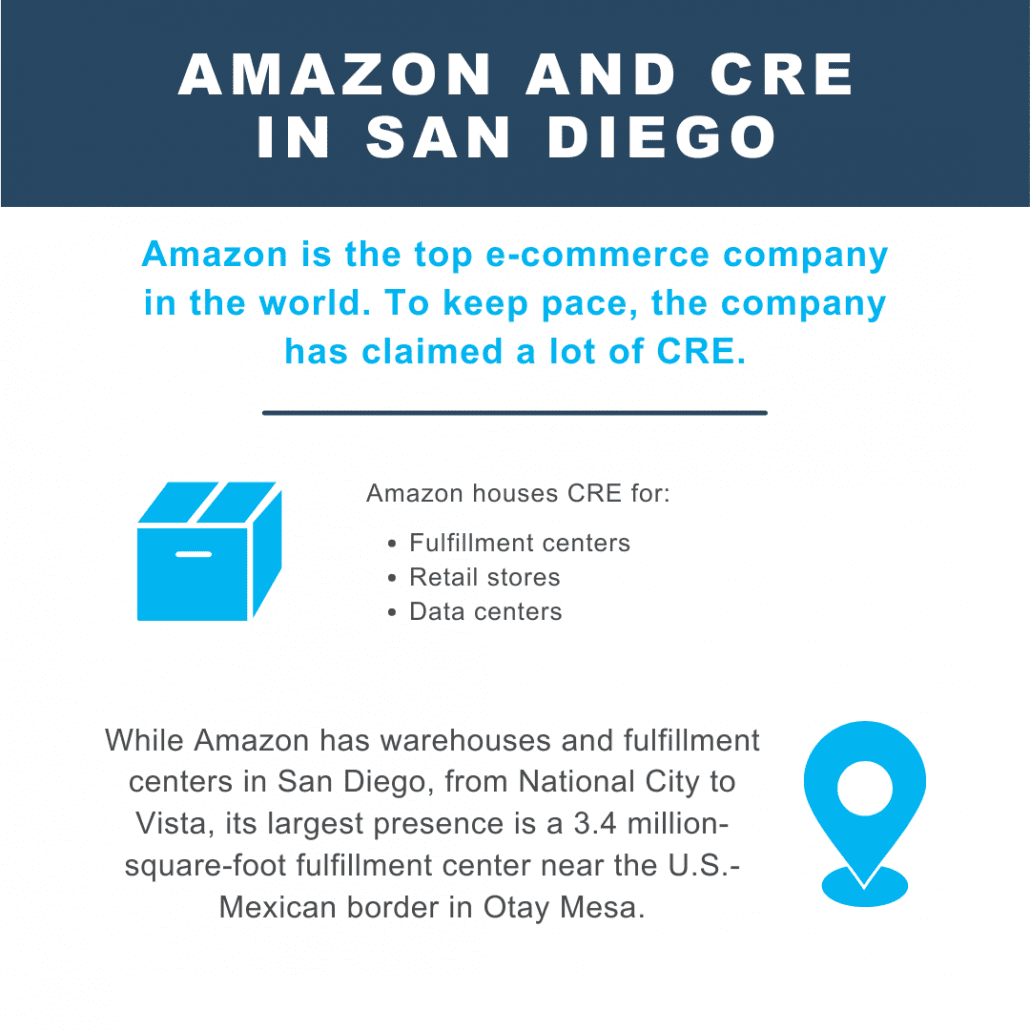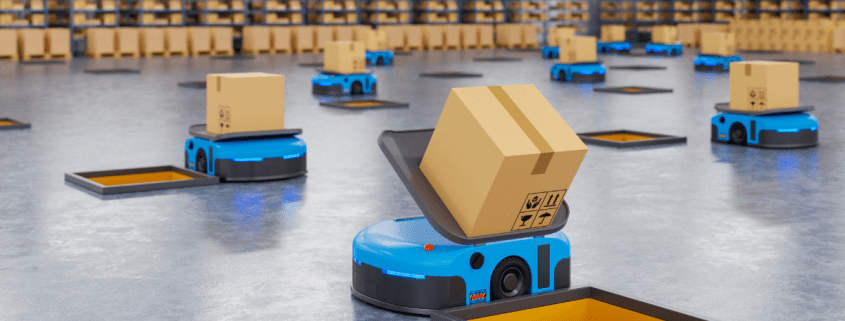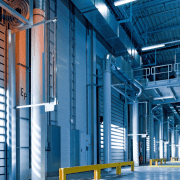How Amazon Growth is Affecting Commercial Real Estate in San Diego
Reviewing The San Diego Union-Tribune’s “Amazon keeps growing in San Diego and Tijuana. Chances are it won’t stop”
Amazon is the top e-commerce company in the world, bringing over $125.6 billion in sales revenue in the fourth quarter of 2020 alone. To keep pace with their sales, Amazon has claimed multiple lots of commercial real estate around the globe.
In fact, according to FBA, Amazon has “110 active fulfillment centers in the US and 185 centers globally,” with the largest fulfillment center nearing four million square feet.
That’s a lot of real estate. The San Diego-Union Tribune thinks so, too—which is why they’ve written the article “Amazon keeps growing in San Diego and Tijuana. Chances are it won’t stop.”
Before delving into their article, here’s a high-level overview of what Amazon growth means for commercial real estate.

What Does Amazon Growth Mean for CRE?
So, what does Amazon—one of the big five companies in the U.S. information technology industry—growth mean for the commercial real estate industry?
Well, first it’s important to note that Amazon requires a very specific type of commercial real estate: mega warehouses, for the most part. In addition to their warehouses, Amazon also takes up CRE with their:
- Retail stores
- Data centers/cloud computing
- Also, did you know that Amazon owns Whole Foods?
Much of this commercial real estate didn’t exist five years ago, according to GlobeSt.
As we wrote in a recent blog post, long gone are the days where warehouses live in the middle of nowhere or alongside a highway. “Retailers want to get packages to doors in the least amount of time,” writes NPR. “Which means jockeying for storage in expensive and crowded urban and suburban areas.”
In order to keep pace with their promise of a quick delivery, Amazon (and other large e-commerce companies) are vying for quality commercial spaces.
But securing quality CRE is often easier said than done.
Once deemed the ugly duckling, industrial CRE has been hotter than ever since the pandemic began and e-commerce started to boom.
According to Financial Times, industrial vacancy rates hit a historic low of 3.6% in the third quarter of 2021 nationwide. This, coupled with Amazon’s fast-paced growth (GlobeSt reports Amazon is ‘on pace to absorb nearly 120 million square feet of space a year”) has had a significant impact on the property market.
SIOR and others call it ‘The Amazon effect.’
An example of the Amazon effect? The company’s footprint in San Diego and neighboring Tijuana.
Although Amazon has warehouses and fulfillment centers in San Diego from National City to Vista, its largest presence, according to The San Diego Union-Tribune, “is near the U.S.-Mexican border in Otay Mesa”—a 3.4 million-square-foot fulfillment center.
Read on for what Amazon growth means for the San Diego CRE market in the full Union-Tribune article below:
Retail giant Amazon has been leasing and buying space in San Diego more than any other business and, with competition at its heels, doesn’t appear to be slowing down — especially with pandemic-induced shopping.
Seattle-based Amazon now owns or leases roughly 5.3 million square feet of warehouse space across nine facilities in San Diego County. It also has plans for another 900,000-square foot warehouse and recently added a 344,000-square-foot facility in Tijuana.
Experts who study Amazon and retail trends say the company is in a full-court press to solidify its same-day service model for Prime customers as e-commerce experienced significant growth throughout the pandemic.
It is acting quickly, they say, as Walmart rapidly transforms its locations into mini-hubs for its own same-day delivery service, Walmart+. Amazon also faces competition from Target, which owns a similar web service called Shipt. Unlike Amazon, the big boxes don’t need need to go to a local city council to get approval for a new building because all their locations already exist.
All three businesses have accelerated plans as the pandemic greatly changed shopping patterns. Unable or unwilling to travel to brick-and-mortar businesses, Americans and Mexicans increasingly turned to online shopping in the last 1 1/2 years. Analysts say that the growth in e-commerce, probably more than concern over Walmart or Target, is why you will increasingly see Amazon’s presence in your neighborhood.
In 2020, more than 2 billion people purchased goods or services online, said market research firm Statista. Eleven percent of retail sales in the United States came from e-commerce before the pandemic but doubled to 22 percent at the peak of the pandemic during 2020. In Mexico, e-commerce transactions accounted for 4.9 percent of retail sales pre-pandemic but reached 8.9 percent in 2020.
Amazon has warehouses and fulfillment centers throughout the region, from National City to Vista, but its largest presence is near the U.S.-Mexican border in Otay Mesa. It opened a 3.4 million-square-foot fulfillment center in August, has begun construction on a 702,535-square-foot sorting facility nearby and bought a 63-acre site across the street in September.
There is a lot of speculation why Amazon is building so much near the border. When it opened its warehouse in Tijuana, the Internet was rife with rumors that the company was taking advantage of new tariff laws by having facilities a few miles apart in both nations. The implication was products were shipped into Mexico, disassembled and then shipped over to the U.S. Amazon has denied this. A graduate student whose research was cited on Twitter said his work was not relevant to the tariff discussion.
Real estate experts say the explanation might be simpler: Otay Mesa has the cheapest industrial land in San Diego County and is the easiest place to get plans approved. Also, the growth in e-commerce in Mexico means there is a viable market there.
“This new fulfillment center (in Tijuana) is focused solely on the Mexican market and our clients in Mexico,” said Amazon spokeswoman Marisa Vano.
She said Mexico now has 10 fulfillment centers and 31 delivery stations throughout the nation, and the Tijuana facility will serve more than residents in the city — reaching customers in Mexicali, Tecate, Ensenada and Rosarito.
There is still skepticism Tijuana needs an Amazon distribution center. Flavio Olivera, former director of Tijuana’s economic department, said he thought it was unlikely that e-commerce was big enough in the Mexican city to warrant an Amazon facility, in part because its address system is less built-out than in the U.S. — meaning it’s hard to ship things to customers even if the market was there.
“I think it will be more of a support center for the Otay warehouse,” he said.
Even if Amazon isn’t physically shipping goods across the border, Olivera said, it might serve as a pipeline for workers. The United States-Mexico-Canada Agreement, which took the place of NAFTA, allows for intercompany visas, which are not subject to the United States’ traditional immigrant worker quotas.
While the situation is different because of contrasts in border crossings, there is some precedent in Amazon using workers from other nations. In June 2015, workers in Germany had a strike day and Polish employees said they were ordered to work an hour of overtime to make sure customers in Germany still got packages during the labor action.
Amazon’s growth in San Diego County is not happening in a bubble. The company is greatly increasing its presence in every market it operates in the world. The payoff in remaining the top online retail dog could be worth it.
“Amazon is clearly positioning for a market in (San Diego County),” said Nada Sanders, a professor of supply chain management at Northeastern University. “They don’t make any moves randomly.”
Sanders said the Seattle-based company is analytics-driven and growth in San Diego County is based on where it sees growth in online shoppers. Amazon has been expanding its footprint in Denver, Philadelphia, Austin, Nashville and other markets with strong job growth. It is building nine of the 10 biggest warehouses in the United States, said Warehouse Automation, using data from real estate tracker CommercialEdge.
She said global supply chain issues mean companies of all shapes and sizes are trying to position themselves, and their products, closer to customers. Part of that for Amazon is likely making sure they have stockpiled enough products for Prime customers, Sanders said, and get ready as a leader in available goods in time for the holidays.
Amazon’s biggest hurdles appear to be getting projects approved in San Diego, whereas the challenge in Baja California might be delivery. Without easily found addresses for most residents, the company said if it can not find an address in Tijuana it will send it back to the fulfillment center for “geolocation correction” and reach out to customers for additional information about where they live.
However, the city has experienced a boom in luxury condos in recent years that often have large mail rooms that can take packages.
Tijuana
Amazon made waves in September when it opened a 344,000-square-foot fulfillment center in Tijuana next to a ramshackle neighborhood that appeared to critics to embody the evils of capitalism.
There are tax advantages for U.S. companies to position themselves near the border because of the new United States-Mexico-Canada Agreement, nicknamed “NAFTA 2.0,” signed by the Trump administration. It uses a system called “nearshoring,” which gives U.S. and Canadian companies tax advantages for outsourcing to Mexico for cheap labor instead of Asia.
For example, Santa Cruz-based headset manufacturer Poly moved production from China to Tijuana in January, investing $3.2 million and creating 1,450 jobs.
Part of the advantage comes from reduced tariffs. One of the rules from the new agreement, often called Section 321, allows goods in Mexico costing less than $800 to cross the U.S. border to customers duty-free.
It would seem that Amazon could somehow take advantage of this in Tijuana but Sanders says it is unlikely. One of the biggest reasons could be border wait times, which can exceed four hours at the Otay Mesa crossing. There is also the complicated nature of Amazon’s business: It mainly sells third-party goods, and those sellers — not Amazon — would pay the tariffs.
Job postings at the Tijuana Amazon facility describe the work as “picking, packing and shipping customer orders.” The warehouse jobs pay up to 7,875 pesos a month (about $385 in U.S. dollars) with medical and other benefits. Shifts include nights and days, and usually one weekend day a week. It also requires workers to speak Spanish and does not mention English.
The Tijuana job description is nearly identical to warehouse job descriptions for similar positions in San Diego County. However, the pay is significantly higher on the American side, starting at $16.75 an hour for most warehouse jobs, roughly $2,791 a month. While Tijuana’s wages might be seen as good for the area, the pay is considered low for San Diego County — which had a $30.91 average hourly wage in May 2020, said the U.S. Bureau of Labor Statistics.
Sanders said Amazon is a company that is often thinking several steps ahead, which makes it difficult to imagine a plan to use the Tijuana facility for the U.S. market. The reason? Tariff rules can change with the stroke of a pen based on whoever is in power on both sides of the border.
The Amazon effect
Many people who never shopped online before the pandemic, or were not big users, suddenly found themselves frequently on Amazon.
Joan Martinez, 43, of Chula Vista, said she held off on getting an Amazon Prime account for years but now it is part of daily life for her and her 15-year-old son and 13-year-old daughter.
“I quickly realized that it was the way to go with the pandemic closures,” she said, “and it was a game-changer from there. I was just buying everything and anything we needed at the house.”
The gray and blue Amazon Prime truck has become ubiquitous in San Diego County with the vehicles darting in and out of every community.
Experts say Amazon doesn’t put up a warehouse somewhere unless they already have a growing customer base. That still doesn’t stop vocal community members from stopping or delaying the construction of a new distribution center — as was the case recently in El Cajon. In the case of Tijuana, its location might have more to do with the anticipation of growth rather than an existing customer base.
Barry Eidlin, a sociology professor a McGill University who has studied Amazon and its impact on labor, said it’s not fair to blame the consumer for Amazon’s growth. He said looking at the value Amazon provides should be a different bucket than mixing it in with things people often criticize the company for — working conditions and putting bookstores out of business.
“It’s understandable a lot of people want the convenience and go to one website and find a lot of things they need on a day-to-day basis,” he said.
A recent New York Times investigation found the retailer has a 150 percent turnover rate each year at its warehouses. It said it loses nearly 3 percent of its warehouse workers each week. That’s almost double the rate of averages in the retail and logistics industry, said studies used by the paper from ADP Research.
Amazon is paying more than the minimum wage in San Diego County but workers in other markets, such as those in a recent failed union vote at an Alabama facility, have alleged tough working conditions and fought for higher wages.
“We need a world where we can have a degree of convenience and innovation and new ways of providing goods and services,” Eidlin said, “but in a way that also doesn’t treat workers like robots and provides decent wages and working conditions.”
He said it’s not correct to compare Amazon jobs, which may pay more than than a mom-and-pop retailer that shut down, to retail jobs. He said Amazon work should be compared to warehouse jobs, which often pay much more than the retailer.
It can be difficult for customers wanting to make a moral decision to avoid the company because Amazon’s reach is considerable. Martha Sullivan, 62, of Imperial Beach, said she tried to limit her usage of the company because of labor issues she has read about at warehouses by stopping ordering from grocer Whole Foods, which is owned by Amazon.
Sullivan said she wasn’t thrilled with Amazon founder Jeff Bezos’ recent trip to space with his other company, Blue Origin. In an interview with ABC News after the flight, Bezos thanked Amazon workers and customers for paying for the trip — which received considerable criticism tied to wages and working conditions.
However, she said she still orders from grocery service Amazon Fresh twice a week.
“If I was really tough, I would say ‘I’m so pissed off at spending money on space travel that I shouldn’t do anything with them’,” Sullivan said. “But I haven’t gotten there. It’s convenient.”










